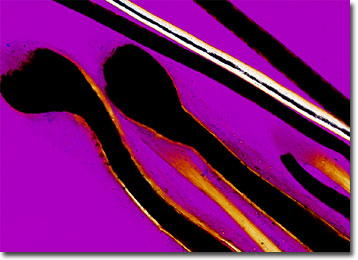Polarized Light Microscopy Digital Image Gallery
Persian Lamb Hair
In the fur trade, Persian lamb refers to the skins of newborn lambs of the Karakul breed, which feature glossy black, tightly wound curls of fur. Utilized primarily in the fashion industry, demand for Persian lamb varies with clothing trends.

The Karakul is believed to be one of the oldest breeds of domesticated sheep. Of central Asian origin, the animal, which was originally utilized for a wide array of purposes, such as a source of meat, milk, tallow, and fiber, is extremely hardy and can adapt to life in harsh conditions. The sheep is also resistant to certain parasites and diseases, such as foot rot. Yet, the most distinctive characteristic of the breed is its colored fleece. A dominant black gene results in the beautiful coal-colored coats of the young lambs. This color tends to alter somewhat with age, however, adult Karakulís typically exhibiting hues of browns and grays. The fleece of adults is sometimes used for felts, carpeting, and saddle blankets, but does not command the high prices associated with the skin of the lambs.
Over the last few decades, a certain amount of controversy has been associated with Persian lamb. Animal rights groups have attempted to expose the inhumanity of the practices involved in obtaining the material, but many of the charges they put forward are adamantly denied by those in the industry. Activists, for instance, claim that Karakul newborns and fetuses, the pelts of which are referred to as broadtail lamb, are being slaughtered solely for their skins, which garner extremely high prices, but producers argue that the skins are only a byproduct of meat production. An investigation carried out in March 2000 by the Humane Society of the United States at a Karakul farm in Bukhara, Uzbekistan seems to support many of the claims made by animal rights groups, but the demand for Persian lamb has yet to dissipate.
